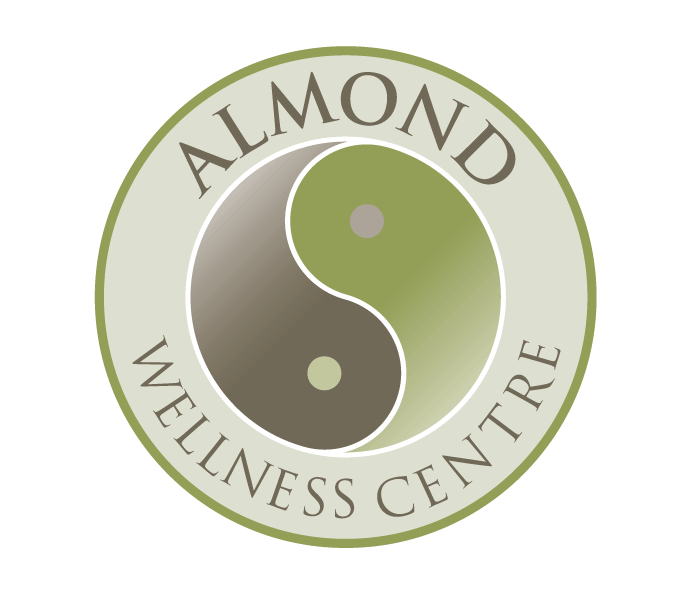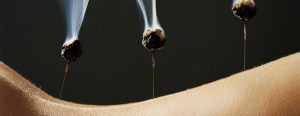
Moxibustion Treatment Melbourne
What is moxibustion?
This ancient practice has been highly regarded by Chinese medicine practitioners for its therapeutic benefits. The concentrated heat generated from burning moxa penetrates the skin, providing strong heat that helps alleviate various health issues.
Historical Perspective

“When acupuncture does not help, moxibustion works”
Moxibustion has been praised throughout Chinese medical history. The “Huangdi Neijing – Lingshu” states: “针所不为,灸之所宜” meaning that “When acupuncture does not help, moxibustion works” This highlights moxibustion’s role as a crucial treatment method when acupuncture alone is insufficient.
Dou Cai of the Southern Song Dynasty extolled moxibustion in his work “Bian Que Xin Shu,” saying, “保命之法,灼艾第一” which translates to “The first method for preserving life is moxibustion.”
Significance of Moxibustion Treatment
In China, the term “acupuncture” is known as “针灸 (zhen jiu),” which encompasses both needling and moxibustion. However, in Western countries, “acupuncture” often refers solely to needling. The original meaning in Traditional Chinese Medicine (TCM) underscores the integral role of moxibustion alongside needling, illustrating its importance in holistic treatment.
How Does Moxibustion Work?
Moxibustion warms and removes obstructions in the body’s meridians, the channels through which Qi (vital energy) flows. By dispelling cold and dampness, moxibustion invigorates the flow of Qi and blood, enhancing the function of internal organs and boosting the immune system. It is often used in conjunction with acupuncture, offering a complementary approach when acupuncture alone does not yield the desired results.
Types of Moxibustion
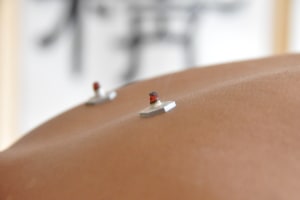
moxibustion treatment on back
- Direct Moxibustion:
- Non-Scarring: Uses smaller cones that do not burn the skin, leaving no scars.
- Scarring: Utilises larger cones that can cause burns and scars.
- Indirect Moxibustion:
- With Ginger, Garlic, Salt, or Herbal Biscuit: Various substances are placed between the skin and the burning moxa.
- With Moxa Stick: A moxa stick is held near the skin, providing heat without direct contact.
- With Warming Needle: Moxibustion is applied over inserted acupuncture needles for enhanced effect.
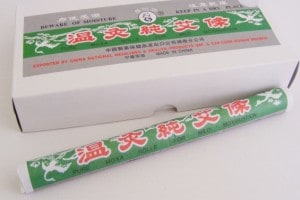
moxa rolls for moxibustion treatment
Benefits of Moxibustion
- Warms and Unblocks Channels: Removes cold and dampness, promoting better Qi and blood flow.
- Strengthens Yang Qi: Bolsters the body’s energy and immune system.
- Enhances Organ Function: Improves the overall health of internal organs.
- Complementary to Acupuncture: Provides additional therapeutic benefits when combined with acupuncture.
Conditions Treated with Moxibustion
Moxibustion can be beneficial for a variety of conditions, including:
- Chronic pain (e.g., arthritis, muscle pain)
- Digestive disorders (e.g., irritable bowel syndrome, diarrhea)
- Gynecological issues (e.g., menstrual cramps, infertility)
- Respiratory problems (e.g., asthma, bronchitis)
- Fatigue and general weakness
- Cold hands and feet due to poor circulation
Moxibustion for Breech Babies
Moxibustion is notably used to help turn breech babies. The heat and stimulation from moxa applied to specific acupuncture points (such as BL67, located near the little toe) can encourage the baby to move into the correct position for birth. This non-invasive method is often recommended by healthcare providers as a natural way to correct breech presentation.
Does Moxibustion Hurt?
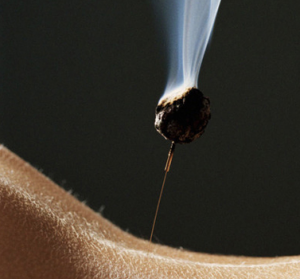
moxibustion on acupuncture needles for back pain
Moxibustion is generally a painless procedure. Patients typically feel a pleasant warming sensation as the moxa burns. In the case of direct moxibustion, there might be a slight risk of minor burns if not properly managed. Indirect moxibustion, where a substance is placed between the skin and moxa or a moxa stick is used, reduces the risk of burns significantly.
Safety of Moxibustion
While moxibustion is considered safe, there are some risks to be aware of:
- Burns and Pain: Direct moxibustion can cause minor burns if not applied carefully.
- Fire Hazard: As moxa involves burning material, there is a potential fire risk if not monitored properly. Practitioners should ensure a safe environment and use appropriate tools to manage the burning moxa.
- Skin Irritation: Some individuals may experience skin irritation from the heat or the moxa itself.
Self-Administered Moxibustion Treatment
Self-administering moxibustion is possible, but it requires proper instruction and caution. It is advisable to first learn the technique from a qualified practitioner to avoid burns and ensure the treatment is effective. Beginners should start with indirect methods, such as using a moxa stick, which are easier to control and pose less risk.
Home Moxibustion Practices
For those considering moxibustion at home, it is recommended to use indirect methods such as suspended moxibustion or moxibustion with an intermediary substance like ginger or salt. Suspended moxibustion involves holding a lit moxa stick a few centimeters above the skin, while moxibustion with an intermediary involves placing a substance between the skin and the moxa.
Important Considerations for Moxibustion
When practicing moxibustion at home, it’s crucial to:
- Ensure proper ventilation to avoid inhaling excessive smoke.
- Focus on safety to prevent burns and fire hazards.
- Avoid moxibustion if you have heat-related conditions or Yin deficiency.
- Seek professional advice if uncertain about suitability.
By understanding and respecting these principles, you can safely incorporate moxibustion into your health regimen.
Moxibustion Treatment in Melbourne
If you’re in Melbourne and seeking a holistic approach to health that complements acupuncture, consider moxibustion at Almond Wellness Centre. Consult our licensed acupuncture practitioners to explore how this traditional therapy can benefit you. Experience the warming, healing effects of moxibustion and enhance your overall well-being.
Contact Almond Wellness Centre today to schedule your moxibustion session and start your journey towards better health.
